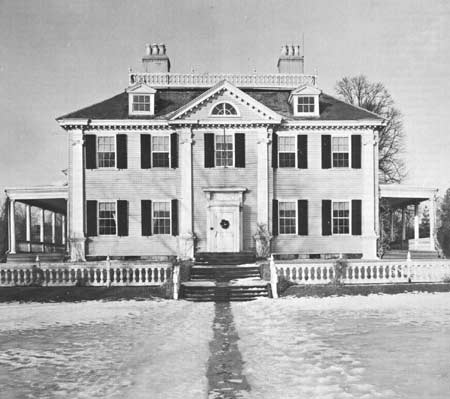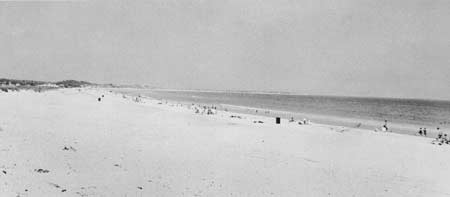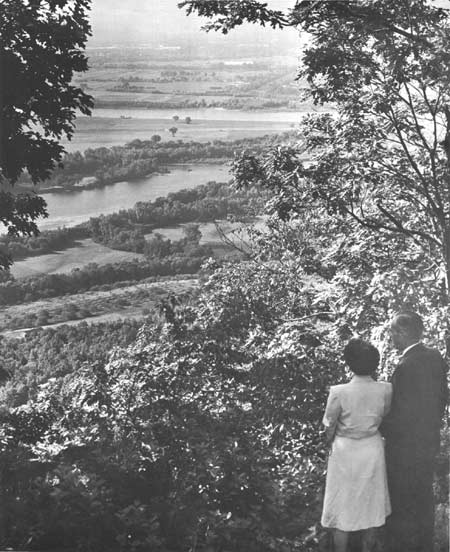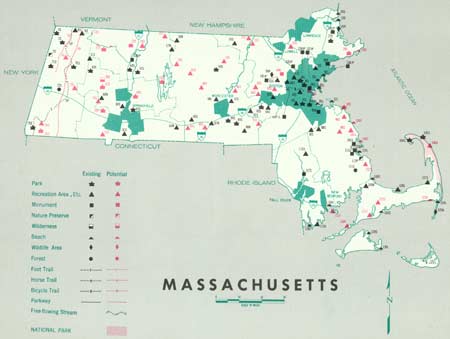.gif)
Parks for America
MENU
|
Parks for America
|

|

|
| The home of Henry Wadsworth Longfellow, architectural masterpiece in Cambridge, Massachusetts, that once served as George Washington's headquarters, is proposed as the Longfellow National Historic Site. |
MASSACHUSETTS
MASSACHUSETTS is a highly populated and industrialized State with an abundant variety of opportunities for seashore and upland recreation.
In the last decade the population increased 9.8 percent, to 5,148,578 in 1960. The forecast for 1976 is 5,489,000. Urban dwellers account for 83.6 percent of the 1960 population. There are 11 metropolitan areas, including Boston.
In the economy, manufacturing and industry rank first, with the research industry of special importance; agriculture ranks second. The tourist industry ranks third with estimated expenditures of $400 million in 1960, of which approximately $250 million comes from out-of-State visitors.
The present State highway system and proposed interstate routes provide easy and rapid access to recreation areas within the State and in adjoining States.
Extensive ocean shoreline with sandy beaches lies close to the major population centers of the New England States and the New York metropolitan region. Wetlands associated with the seashore are important for feeding and nesting of waterfowl. Forested upland regions contain highly scenic mountain ranges, numerous streams, rivers, and lakes. Sixty percent of the State is forested. Winter sports are important in the Berkshire and Wachusett Mountains. Reservoirs and town forests offer possible recreation opportunities. Although State laws provide for fishing on great ponds (over 20 acres), access to these ponds is a problem. The State owns five public fishing sites and leases seven. Fresh and salt water fishing and hunting are of local interest. The State wayside program is well established. Wayside areas of 3 to 6 acres are being developed along the interstate routes.
Urban sprawl is encroaching on open countryside that has been affording recreation and scenic values. Pollution impairs the recreation value of the State's rivers and beaches.
Massachusetts is endowed with many historic sites illustrating the colonial period, origins of the American Revolution, economic growth, and flowering of the 19th-century intellect.
The climate offers recreation opportunities during all four seasons. Summer temperatures in the Berkshires and along the seashore are unusually pleasant. Conditions are fairly dependable for winter sports, which are popular. In the spring, rains and chilly winds limit recreation activities. Fall, with its autumn foliage, is very pleasant. The major recreation season runs from 3 to 4 months.
EXISTING PUBLIC AREAS
NATIONAL: The National Park Service administers 3 historic monuments that had an attendance of 68,000 in 1960. The Fish and Wildlife Service has three national wildlife refuges totaling 9,314 acres. The Corps of Engineers administers seven reservoir areas with 12,468 acres.
STATE: The Division of Forests and Parks administers 11,476 acres in 24 parks and recreation areas that had a 1960 attendance of 1,466,450, and 105 forests with 168,065 acres. The State Reservation Commission has eight areas amounting to 14,214 acres. The Division of Waterways administers six areas containing 5,497 acres. The Division of Fisheries and Game administers 2,133 acres in hunting and fishing areas. The Division of Highways maintains approximately 350 roadside areas. The Trustees of Reservations have jurisdiction over 28 historic sites.
LOCAL: The Boston Metropolitan District Commission administers 13 areas totaling 14,000 acres and the State-owned Bunker Hill Monument. One other historic monument is locally owned.
QUASI-PUBLIC AND PRIVATE: Eight historic monuments of State or national significance are open to the public. Seventy miles of the Appalachian Trail traverse the western part of the State.
PRIVATE ENTERPRISE: The variety of private recreation facilities includes commercial seashore resorts, resort developments in the mountain and lake regions, and more modest family accommodations. They provide for a major portion of the weekend and vacation needs of residents and nonresidents.

|
| The size and location of Duxbury Beach give it prime importance for public recreation in Massachusetts. |
PARK AND RELATED NEEDS
The establishment of Town Conservation Commissions marks an important step toward the preservation of open space, but the need for intensifying the development of comprehensive coordinated planning poses a challenge. Although the State park and forest system is well established, areas require consolidation, expansion, and development. Urgently needed are parks and related areas contiguous to metropolitan areas. Preservation of seashore areas is of critical importance.
Free-flowing streams, rivers, river valleys, and wet lands should be preserved for their natural values. Greater recreation use should be made of water supply and flood-control reservoirs. Boating facilities should be expanded. Foot, horse, bicycle, and canoe trail systems are relatively undeveloped. Natural areas should be expanded. Pollution control and flood-plain zoning are badly needed.
A large number of the State's significant historic sites have been preserved for public use, chiefly by local and private agencies, some with Federal and State assistance, but much remains to be done to make the most of these important inspirational and economic resources. Twenty-five sites have been evaluated as possessing exceptional value in commemorating the history of the United States.
Existing State parks and recreation areas provide approximately 37,115 acres for 5,149,000 residents. Potential State areas identified in this plan total approximately 185,870 acres. Even if these areas are established and developed, there may be a need for additional areas by 1976. Existing local parks and recreation areas provide approximately 13,259 acres. Additional areas should be acquired or developed to meet present and future needs. These figures do not include the acreages of public lands administered primarily for purposes other than recreation. The State forests and fish and game lands, with a combined acreage of approximately 170,000 acres, are largely available for recreation and may offer additional opportunities.

|
| The Connecticut River's famed oxbow area at Hockanum Flat, site of an Indian raid and archeological finds, is proposed as part of a 10,000-acre Holyoke Range State Park. The pastoral river valley is here seen from the existing 375-acre Joseph A. Skinner State Park atop Mount Holyoke. |
RECOMMENDATIONS
Existing recreation resources and many potential areas are shown on the accompanying tabulation and map. It is hoped that the following recommendations, implemented by vigorous action on the part of the agencies concerned, can help provide needed outdoor recreation opportunities for public enjoyment and use.
NATIONAL: Establishment of the Boston National Historic Sites and Longfellow National Historic Site as units of the National Park System. Further study be given to the Elizabeth Islands as a possible national area.
Provision of more adequate public recreation land and facilities on existing flood-control reservoirs.
Reevaluation of the desirability and feasibility of an Appalachian National Parkway, a portion of which might pass through Massachusetts.
STATE: Expansion of the State park system by addition of 5 parks, 13 recreation areas, and 3 public seashores. Four other parks, 15 recreation areas, 1 public seashore, I free-flowing stream, and a park way are suggested for further consideration.
LOCAL: Intensification of efforts to encourage and insure sound planning through such efforts as the Town Conservation Commission activities. Immediate acquisition and development of areas closely related to urban centers for parks and recreation areas, as well as other conservation uses.
Supporting recommendations include—
1. Protection of river and stream courses in their natural state through flood-plain zoning and pollution control programs.
2. Acquisition of permanent easements for the Appalachian Trail.
3. Expansion of foot, horse, bicycle, and canoe trail systems, with adequate protective easements.
4. Protection of the scenic and esthetic qualities of existing highways and incorporation of these qualities into the design of future highways.
5. A comprehensive survey of archeological and historic sites with a view to the preservation and development of those possessing sound educational and inspirational values.
(Table omitted from online edition)

|
| (click on image for an enlargement in a new window) |
NEXT >>>
|
|
Last Modified: Mon, Sep 6 2004 10:00:00 pm PDT
parks_america/massachusetts.htm
 Top
Top